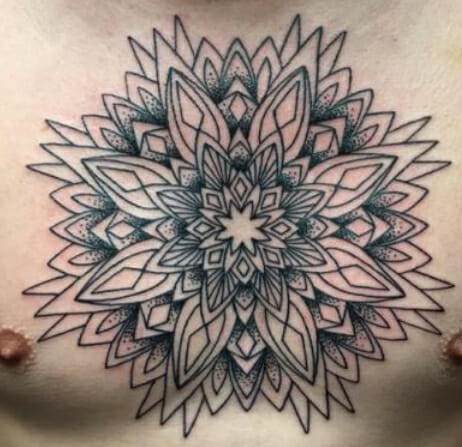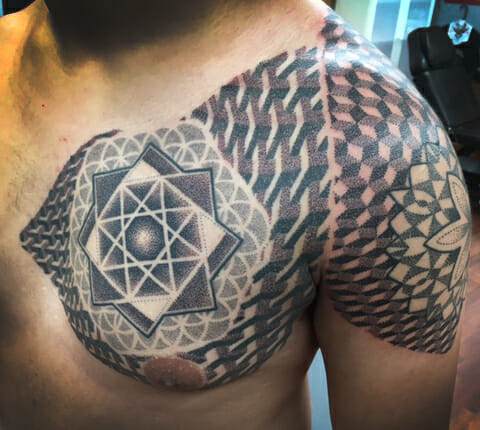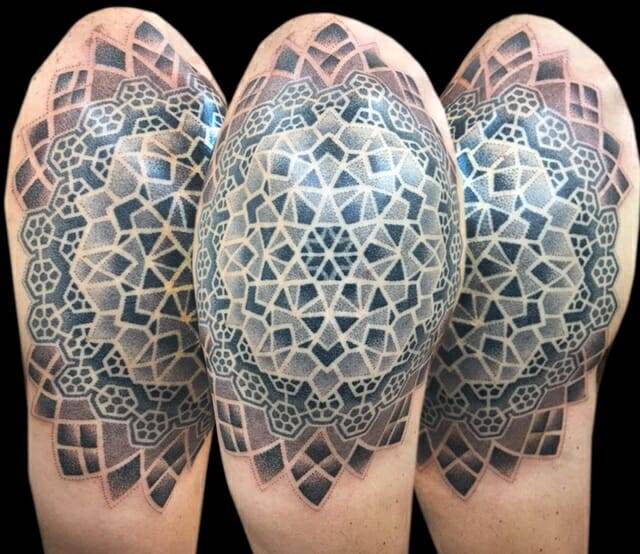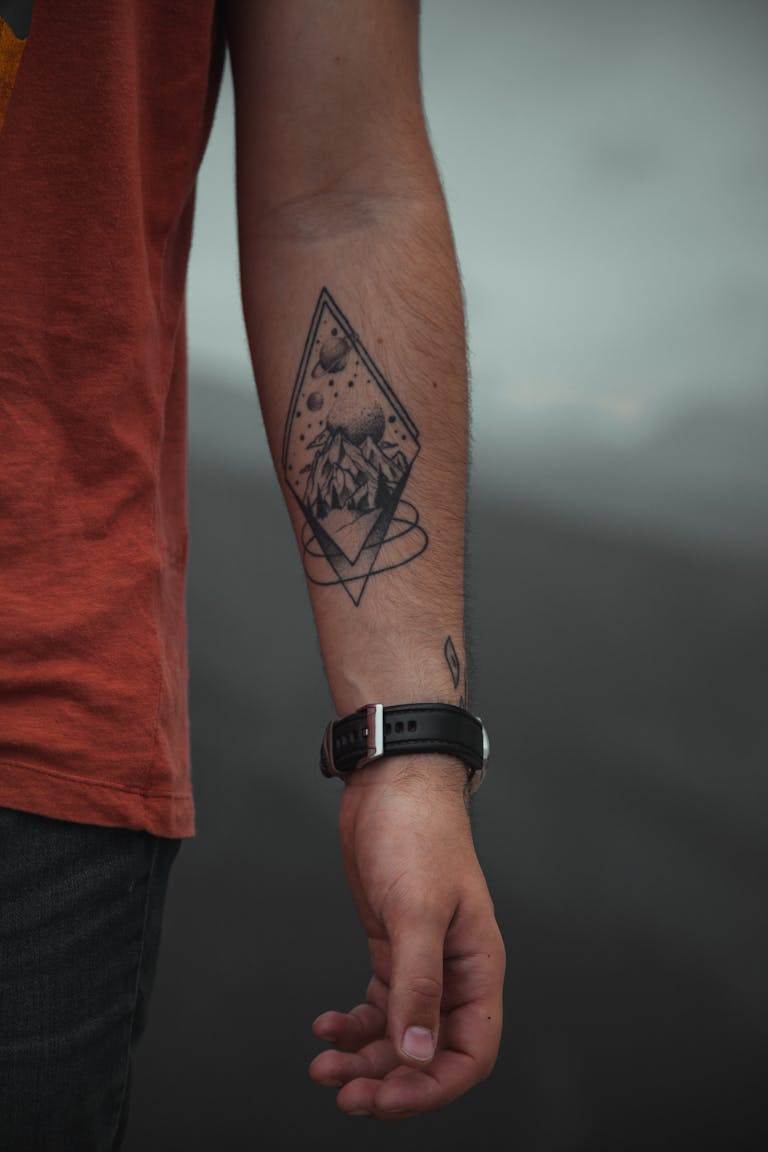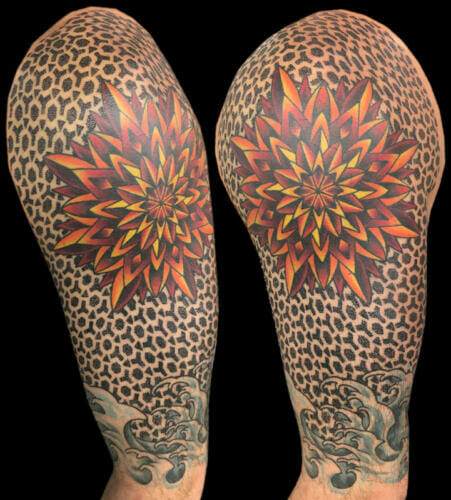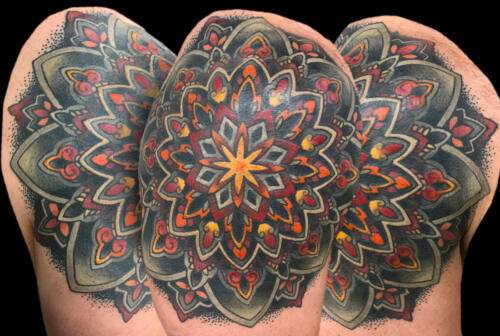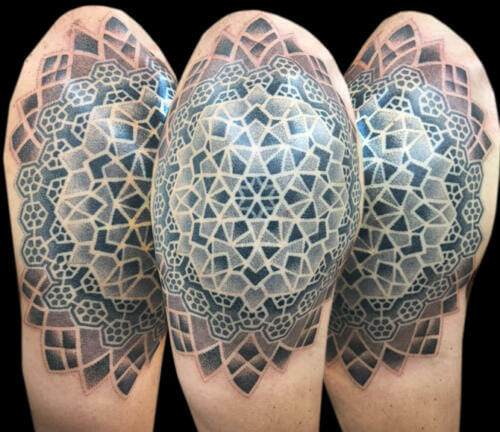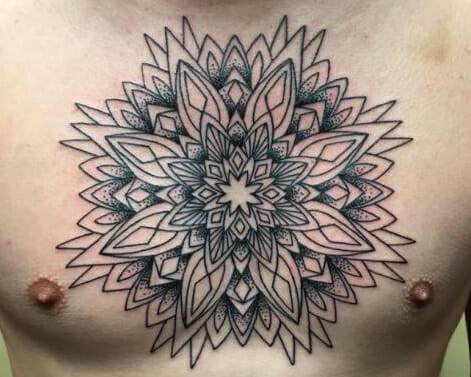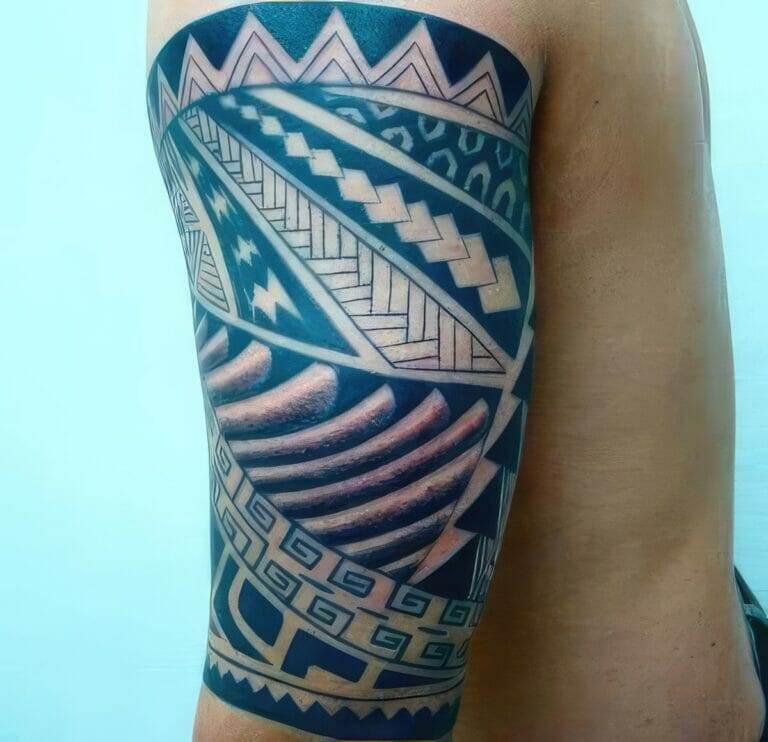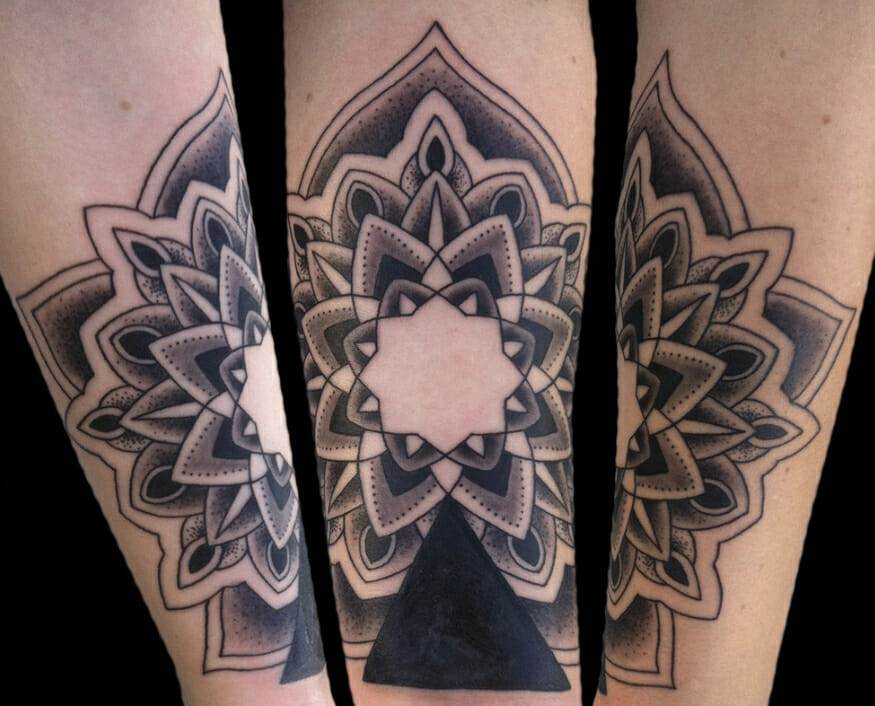
Introduction to geometric and mandala tattoos
Geometric and mandala tattoos have gained immense popularity in recent years. These two artistic styles offer unique and visually appealing designs that have captivated tattoo enthusiasts around the world. Geometric tattoos are characterized by the use of clean lines, shapes, and patterns to create intricate and symmetrical designs. On the other hand, mandala tattoos are known for their circular patterns, often featuring intricate details, symbols, and spiritual significance.
Why they are popular and their significance
Geometric and mandala tattoos are popular for several reasons. Firstly, their aesthetic appeal attracts those who appreciate bold and intricate designs. The geometric patterns offer a sense of symmetry and precision, while the detailed mandalas create a mesmerizing visual effect.
Another reason for their popularity is the deep symbolism behind these tattoos. Geometric tattoos often represent order, balance, and harmony. The use of straight lines and precise shapes symbolizes stability and structure, appealing to those who value these qualities in their lives.
Mandalas, on the other hand, have spiritual significance in various cultures. They represent the universe, unity, and the infinite cycle of life. The intricacy of the design reflects the complexity of our existence and symbolizes the interconnectedness of all beings.
Moreover, these tattoos also hold personal significance for individuals. Many people choose geometric or mandala tattoos to reflect their own beliefs, values, or life experiences.
In summary, geometric and mandala tattoos have gained popularity due to their visually appealing designs and deep symbolism. They serve as unique forms of self-expression and allow individuals to showcase their personal beliefs and values through body art. Whether it’s the order and precision of geometric tattoos or the spiritual significance of mandalas, these tattoos continue to be sought after by tattoo enthusiasts worldwide.
Geometric Tattoos
Geometric tattoo designs and their meanings
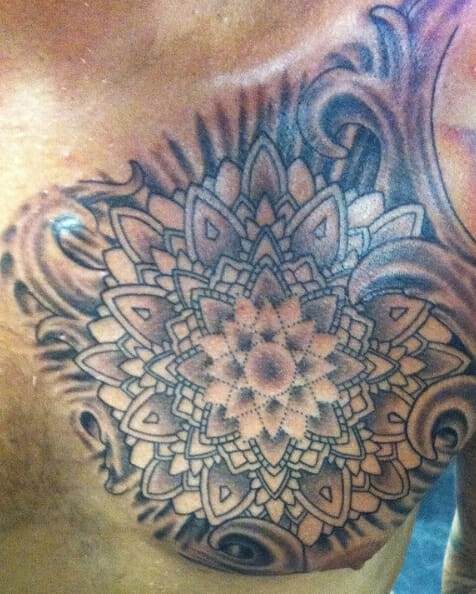
Geometric tattoos feature clean lines, shapes, and patterns that create intricate and symmetrical designs. These tattoos often hold deep meanings for their wearers. Some common meanings associated with geometric tattoos include:
- Order and balance: The use of straight lines and precise shapes in geometric tattoos represents stability and structure. Many individuals choose these designs to symbolize the need for order and balance in their lives.
- Harmony and unity: Geometric tattoos often represent the harmonious coexistence of different elements. These designs showcase the interconnectedness of various parts to create a cohesive whole. They symbolize unity and harmony within oneself and the world.
- Transformation and growth: Geometric patterns often incorporate shapes like triangles or arrows, symbolizing movement and progress. These tattoos can represent personal growth, overcoming challenges, and embracing change.
Popular geometric tattoo styles
Geometric tattoos come in various styles, each offering unique visual appeal. Some popular styles include:
- Dotwork: This style uses a series of dots to create intricate geometrical designs. The meticulous placement and overlapping dots create shading and depth, resulting in visually stunning tattoos.
- Blackwork: Blackwork tattoos rely on solid black ink to create bold and striking designs. These tattoos often feature intricate patterns and negative space, creating a visually striking contrast.
- Minimalistic: Minimalistic geometric tattoos focus on simplicity and clean lines. These designs often use basic shapes such as triangles, circles, or squares to create minimalist yet visually appealing tattoos.
- Geometric animals: Another popular style is combining geometric shapes with animal designs. These tattoos blend the beauty of animals with the precision and symmetry of geometric patterns, creating captivating and meaningful body art.
In conclusion, geometric tattoos offer visually appealing designs and hold deep meanings for their wearers. The various styles and symbolisms associated with geometric tattoos provide individuals with a unique form of self-expression and allow them to showcase their values and beliefs through body art.
Benefits of Sacred Symmetry
The meaning behind sacred symmetry in tattoos
Sacred symmetry refers to the use of geometric patterns and shapes in tattoos to create a sense of balance and harmony. This style of tattooing holds deep meanings for many individuals. Some common meanings associated with sacred symmetry tattoos include:
- Balance and equilibrium: Sacred symmetry tattoos symbolize the need for balance and stability in one’s life. The symmetrical designs represent the equilibrium between opposing forces, creating a sense of harmony within oneself.
- Spiritual connection: Sacred symmetry tattoos often incorporate sacred symbols and geometric patterns that have spiritual significance. They can represent a connection to higher powers, spiritual awakening, and a deeper understanding of oneself and the universe.
- Divine order: The precise and symmetrical nature of sacred symmetry tattoos represents the inherent order and structure found in the universe. These designs symbolize the belief in a greater cosmic order and the interconnectedness of all things.
How sacred symmetry enhances the design
Sacred symmetry adds a unique visual appeal to tattoo designs. The use of geometric patterns and precise symmetry creates a visually striking and aesthetically pleasing effect. Some ways in which sacred symmetry enhances tattoo designs include:
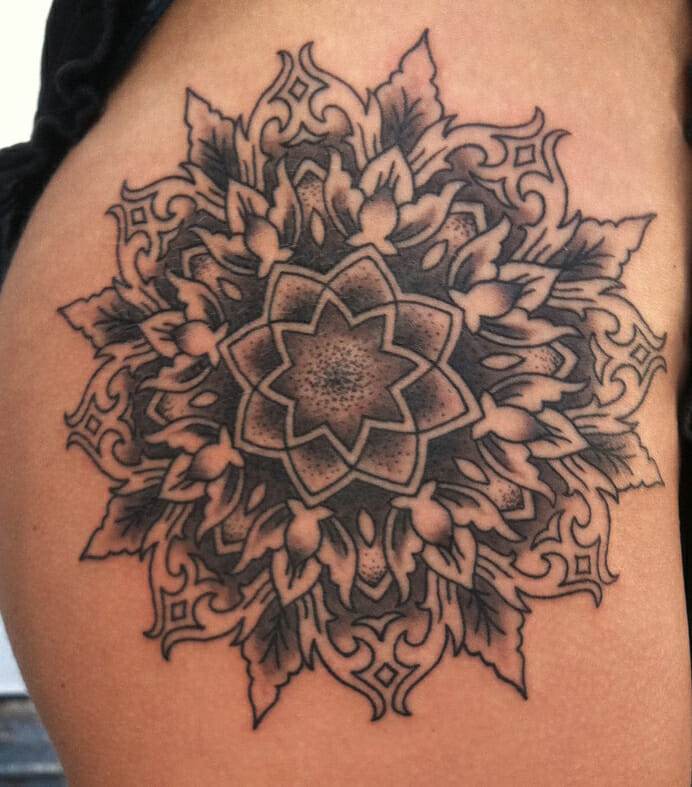
- Visual impact: The symmetrical patterns in sacred symmetry tattoos immediately catch the eye and create a visually captivating effect. The precise lines and shapes draw attention and make the design stand out.
- Balance and harmony: The symmetrical nature of these tattoos creates a sense of balance and harmony within the overall design. It provides a pleasing and balanced composition that is pleasing to the eye.
- Symbolic representation: Sacred symmetry tattoos often incorporate sacred symbols or elements with deep spiritual meaning. The symmetrical placement of these symbols adds to their significance and enhances their symbolic representation.
In conclusion, sacred symmetry tattoos offer a visually appealing and meaningful option for individuals looking to express themselves through body art. The use of geometric patterns and precise symmetry adds depth and symbolism to the designs, creating a unique and impactful tattoo.
Mandala Tattoos
Mandala tattoo meaning and symbolism
Mandala tattoos hold significant meaning and symbolism for many individuals. The word “mandala” originates from Sanskrit and translates to “circle” in English. The circular shape of mandalas represents the universe and wholeness. Here are some meanings and symbols associated with mandala tattoos:
- Spiritual representation: Mandala tattoos often incorporate sacred symbols and geometric patterns that have spiritual significance. They can represent a connection to a higher power, spiritual awakening, and a deeper understanding of oneself and the universe.
- Harmony and balance: The intricate designs and symmetry of mandalas symbolize balance and harmony in life. They represent the equilibrium between opposing forces, creating a sense of tranquility and inner peace.
- Unity and interconnectedness: The intricate patterns within mandalas represent the interconnectedness of all things. Just as all the elements in a mandala design are connected, mandala tattoos symbolize the belief in the interconnectedness of all beings and the oneness of everything.
Different types of mandala designs
There are various types of mandala designs, each with its own unique patterns and meanings. Here are a few popular types of mandalas:
- Traditional mandalas: These designs feature intricate and symmetrical patterns, often inspired by traditional art forms from different cultures like Tibetan, Indian, or Native American. They typically incorporate geometric shapes and symbols.
- Floral mandalas: These designs incorporate elements of nature, such as flowers, leaves, and vines. The floral patterns add a softer and organic touch to the mandala design, often representing growth, beauty, and the cycles of life.
- Animal mandalas: These mandalas feature various animal motifs, such as lions, elephants, or birds. Each animal represents different qualities or characteristics, further adding symbolism and personal meaning to the tattoo.
In conclusion, mandala tattoos offer a visually appealing and meaningful form of body art. The intricate patterns and symbolism behind mandalas make them a popular choice for individuals seeking a tattoo that represents spiritual connection, balance, and unity with the universe. From traditional mandalas to floral or animal-inspired designs, there are various options to choose from when incorporating mandalas into tattoo art.
Finding Inspiration
Sources of inspiration for geometric and mandala tattoos
Geometric and mandala tattoos are popular choices for individuals seeking visually appealing and meaningful body art. Here are some sources of inspiration for these types of tattoos:
- Nature: Many people find inspiration in natural elements such as flowers, leaves, and animals. Using these elements in geometric or mandala designs can add a sense of organic beauty and symbolism to the tattoo.
- Traditional art forms: Drawing inspiration from traditional art forms, such as Tibetan or Native American art, can result in intricate and culturally rich geometric and mandala designs.
- Spiritual and philosophical beliefs: Individuals who have strong spiritual or philosophical beliefs may find inspiration in symbols and concepts that hold meaning to them. These can be incorporated into the tattoo design to reflect their personal journey and beliefs.
- Ancient symbols and cultures: Exploring ancient symbols and cultures can provide a wealth of inspiration for geometric and mandala tattoos. Symbols such as the infinity sign, yin and yang, or sacred geometry can be incorporated into the design, adding layers of meaning and symbolism.
Exploring ancient symbols and cultures
Ancient symbols and cultures offer a treasure trove of inspiration for geometric and mandala tattoos. Here are a few examples:
| Symbol or culture | Meaning |
|---|---|
| Ancient Egyptian | Symbolism of life, death, rebirth, and spirituality |
| Tibetan Buddhism | Representations of enlightenment, the universe, and the interconnectedness of all things |
| Mayan | Symbols of balance, cycles of time, and the natural world |
| Hinduism | Depictions of gods, goddesses, and cosmic forces |
Exploring these ancient symbols and cultures can provide a rich source of inspiration for creating geometric and mandala tattoos that hold personal significance and meaning. Whether it is nature, traditional art, spiritual beliefs, or ancient cultures, finding inspiration for these tattoos is an exciting process that allows individuals to create a truly unique and meaningful tattoo design.

